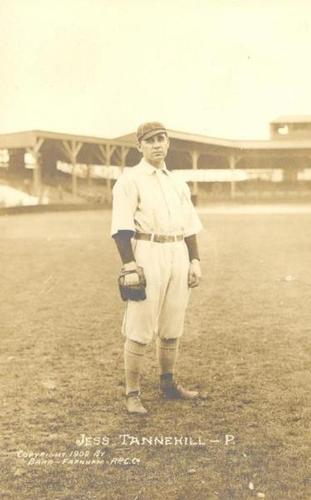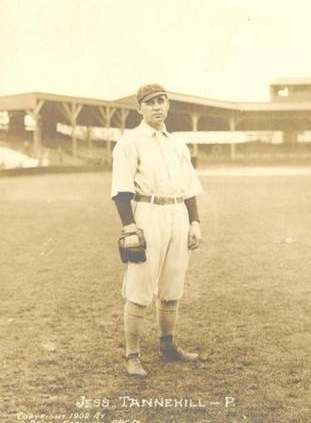August 17, 1904: Jesse Tannehill throws Boston’s second no-hitter of season
 Jesse Tannehill led the National League in ERA in 1901 with the Pittsburgh Pirates and was a four-time 20-game winner in Pittsburgh. He jumped to the American League’s New York Highlanders in 1903 but had an off-year, 15-15 with an ERA that had climbed from 1.95 to 3.27.
Jesse Tannehill led the National League in ERA in 1901 with the Pittsburgh Pirates and was a four-time 20-game winner in Pittsburgh. He jumped to the American League’s New York Highlanders in 1903 but had an off-year, 15-15 with an ERA that had climbed from 1.95 to 3.27.
Fresh off winning the first World Series between the American and National Leagues, the Boston Americans traded one of their top pitchers, Long Tom Hughes (20-7, 2.57), for Tannehill in December 1903. Hughes had worked only two innings in the Series, though, losing Game Three, and apparently manager Jimmy Collins had some difficulty with him, maybe didn’t see eye-to-eye.1
In acquiring Tannehill, Collins was taking on a “veteran southpaw whose star was thought by many to be setting.”2 Tannehill rebounded in 1904, though, and had an excellent season with Boston, complementing a staff led by 37-year-old Cy Young and 1903 World Series hero Bill Dinneen.
In mid-August 1904, the Boston team pulled into Chicago for a four-game series with the White Sox. Tannehill worked the first game, on August 14, a 5-2 win that pulled the Americans into a virtual tie for first place with the White Sox.3 Chicago rebounded to beat Dinneen the next day and shut out Young and the Bostons the day after that, 6-0.
Tannehill was brought back on two days’ rest to pitch yet again on August 17. Going back to his win over the St. Louis Browns on August 11, it was his third start in just seven days. Collins opted to pitch the 30-year-old Tannehill instead of fourth starter Norwood Gibson, and the move paid off.
The August 17 game took place on a Wednesday afternoon at South Side Park. The Americans faced former teammate Nick Altrock, a 15-game winner who had lost to Tannehill in the series opener. Boston scored one run in the top of the first on a one-out single up the middle and into center by shortstop Freddy Parent, a walk to center fielder Chick Stahl, and a “corking drive” over first base and into right field by third baseman (and manager) Collins.4
The Americans had a chance to add more runs, but right fielder Buck Freeman slashed a drive off Altrock’s glove – and into a somewhat complicated, inning-ending double play. Altrock recovered the ball and caught Stahl between third base and home. Stahl was tagged out by catcher Billy Sullivan, who then alertly spotted Freeman advancing after rounding first base. Sullivan threw to second baseman Gus Dundon, whereupon Dundon saw Collins break for the plate. Dundon threw home, to Altrock covering, and Chicago had its third out.
“The whole thing was pulled off so fast that it was several seconds before the fans realized the situation,” reported the Chicago Tribune.5 It was 1-0, Boston.
Tannehill hit Chicago’s very first batter in the ribs – leadoff man and right fielder Danny Green. Green was sacrificed to second by center fielder (and White Sox manager) Fielder Jones. Jimmy “Nixey” Callahan, formerly a pitcher but now in left field, made the second out, but Tannehill walked shortstop George Davis. Lee Tannehill – the pitcher’s younger brother by six years, and Chicago’s third baseman – flied out.
From the point on, not a White Sox batter reached first base. Boston catcher Duke Farrell ran down a foul popup in the second inning; along the way, he also recorded four putouts on Tannehill’s strikeouts.
Boston got three more runs in the top of the third against Altrock. Left fielder Kip Selbach singled over second. Parent sacrificed toward third, and Selbach went first to third, seeing the bag had been left uncovered. Stahl doubled to left for the first run. Collins tripled all the way to the fence in left field. Freeman singled again and drove in Collins for a 4-0 lead.
Ed Walsh took over pitching for the White Sox in the fourth. He threw five innings of scoreless ball through the eighth inning, allowing just one hit but walking five, but was tagged for three hits and two more runs in the top of the ninth. Jesse Tannehill started the uprising by “planting a pretty single in left.”6 Selbach doubled to the wall in left. Parent reached on an infield single, scoring Tannehill with Selbach going to third. A wild pitch allowed Selbach to score, making it 6-0.
By the seventh inning, the Chicago Tribune noted, Tannehill’s work was so “brilliant” that the Chicago crowd (reported at 10,000) “began rooting for him to complete his wonderful record, and cheered the end of each round.”7
There were two noteworthy plays on defense near the end of the game, one in the eighth and the other in the bottom of the ninth. In the eighth, Dundon hit a ball hard off Tannehill’s glove, and it glanced off between first base and second baseman Hobe Ferris – behind Ferris, who was running toward second base to try to stop the ball. He quickly reversed course and “half stumbling, picked up the ball and shot it to first,” just beating a diving Dundon.8
Leading off the ninth was Walsh, who struck out. Green – reportedly the fastest runner on the White Sox – hit a ball up the middle. A “yell went up, and the ice had apparently been broken, and nothing short of a miracle could prevent that drive from being a base-hit.”9
There came such a “miracle.” Shortstop Parent dashed for it, grabbed it, and while still in motion and unable to set himself properly, fired a ball to Candy LaChance at first base, just beating Green. With two outs, Jones hit one hard to Ferris, who bobbled the ball but got a grip on it just in time to throw out Jones “by an eyelash.”10
The 6-0 final was the reverse of the score from the previous day. The Chicago Inter-Ocean assessed Tannehill’s pitching style: “He had his speed, but he never used it, save on rare occasions, depending on a slow, seductive drop and an alluring curve ball that barely shaved the outside corner of the plate.”11 The paper’s correspondent added that Tannehill received “almost phenomenal fielding” as well as the six runs the team put across.
It was the second no-hitter of the 1904 season for the Boston Americans; Young had thrown a perfect game three months earlier, on May 5. Before that, Jimmy “Nixey” Callahan – who went 0-for-3 in Tannehill’s no-hitter as Chicago’s left fielder – had recorded the AL’s most recent no-hitter, in September 1902.12
After the game, the winners took a 10:30 P.M. train back to Boston, where they won nine of their next 11 games. In all, Jesse Tannehill started seven games in the month of August and recorded wins in every one of them. He finished 1904 with a 21-11 record and 2.04 ERA, second on the Americans to Young’s 1.97 mark.
The Boston team battled for first place for the rest of the season. As late as October 7, they dipped down to half a game out of first place, but then won three games in a row over New York – and the American League pennant, finishing 1½ games ahead of the Highlanders.
There was no World Series in 1904, with John McGraw’s New York Giants declining to play the American League champs. It was only in 1905 that the World Series resumed and truly became an annual event.
Acknowledgments
This article was fact-checked by Mike Huber and copy-edited by Len Levin.
Photo credit: Jesse Tannehill, Trading Card Database.
Sources
In addition to the sources cited in the Notes, the author consulted Baseball-Reference.com and Retrosheet.org.
https://www.baseball-reference.com/boxes/CHA/CHA190408170.shtml
https://www.retrosheet.org/boxesetc/1904/B08170CHA1904.htm
Notes
1 John Stahl, “Long Tom Hughes,” SABR Biography Project, https://sabr.org/bioproj/person/Tom-Hughes/; Nathaniel Staley, “Jesse Tannehill,” SABR Biography Project, https://sabr.org/bioproj/person/jesse-tannehill/. Accessed June 23, 2024.
2 “A No-Hit, No-Run Game,” Boston Journal, August 18, 1904: 3.
3 Boston was 59-39 (.602) and Chicago was 60-40 (.600.)
4 “Not a Hit Made off Tannehill,” Boston Globe, August 18, 1904: 2.
5 “Great Pitching Beats White Sox,” Chicago Tribune, August 18, 1904: 6.
6 “Not a Hit Made off Tannehill.”
7 “Great Pitching Beats White Sox,” Chicago Tribune, August 18, 1904: 6.
8 “Not a Hit Made off Tannehill.”
9 “Not a Hit Made off Tannehill.”
10 “Not a Hit Made off Tannehill.”
11 “Nary a Hit Did Jesse Allow Us,” Chicago Inter-Ocean, August 18, 1904: 4.
12 For many years, it was believed that Callahan’s no-hitter was the first in AL history, but twenty-first-century research has revealed that Pete Dowling of the Cleveland Blues may have thrown a no-hitter in June 1901, the AL’s first season as a major league. If one includes Dowling, four of the first eight no-hitters in league history were thrown by Boston pitchers. The next four were by Philadelphia’s Weldon Henley (July 22, 1905), Frank Smith of the White Sox (September 6, 1905), Boston’s Bill Dinneen (September 27, 1905), and Cy Young for the newly named Boston Red Sox (June 30, 1908).
Additional Stats
Boston Americans 6
Chicago White Sox 0
South Side Park
Chicago, IL
Box Score + PBP:
Corrections? Additions?
If you can help us improve this game story, contact us.


